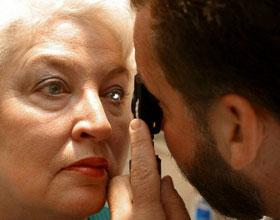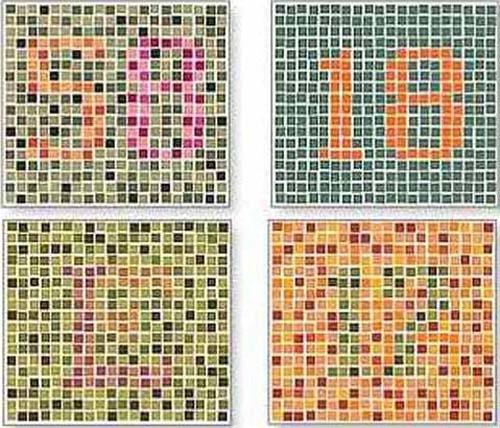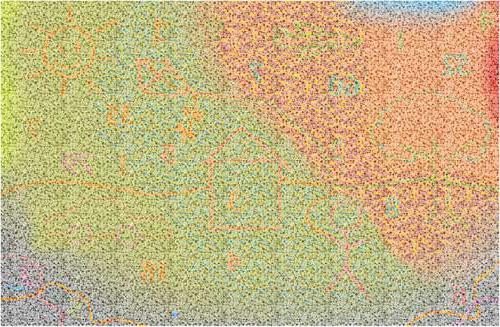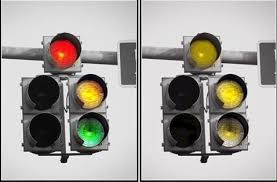Driving license marked daltonik. Color blindmen allowed to drive cars
Even if you have never met a person who is unable to distinguish any colors, you need to say that color blindness is a fairly common disease of our time. Among the inhabitants of the planet can be color blind, not only people. Many animals are "owners" of color blindness. For example, the bulls are not familiar at all, but with fearsome predators, like lions and tigers, only blue and green are known. Similarly perceive the colors of cats and dogs. Walruses, whales and dolphins do not distinguish colors in general and see the world around them in black and white.
Why not all colors are available to the eye?
The retina of the human eye is a complex, multi-factor instrument of the organ of vision, which transforms the light stimulus and allows you to see the object in its exact form and with all shades of color. It is equipped with photosensitive cones containing a pigment responsible for determining color. A person has three types of light sensors located on the retina, the so-called cones. Each one contains a specific set of protein pigments. Speaking in an unscientific language, each of these cones is responsible for the perception of a particular color: red, green, and blue. In the case when one of the set of protein pigments is missing, the person loses the ability to perceive a certain color. In the normal operation of all three sensors, a person distinguishes about a million shades of color, but with two, only 10,000 (100 times less). Color blindness is a deviation from the norm when the work of at least one light sensor is disrupted.

People with color blindness hardly perceive shades, but can recognize colors by brightness or tones, cold or warm. Color blind people do not always know about their disease and do not notice their differences in perception from the sensations of other people. This helps them to memory. It is the memory and brightness of the image that allows them to judge a particular color and compare it with another palette.
Types of color blindness
Color blindness also has many varieties. Sometimes a person has less than three color cones since birth. From here and groups of people on perception of color:
Trichromates (normal, all three flasks of protein pigments function in the retina).
Dichromates (only two cones are functioning; problems arise with the recognition of many shades).

It was this deviation that John Dalton, an English natural scientist, identified in himself, and was the first to describe color blindness from a scientific point of view on his own feelings. He just belonged to the group of dichromates, when the red and green colors are seen as different. The first work on color blindness D. Dalton wrote at the end of the XVIII century.
Monochromats (only one type of cones functions; in this case, a test for color blindness will show that people do not know about flowers, the whole world is black and white for them).
Abnormal trichromats
There are deviations in people whose retina is equipped with all three light sensors, and it would seem that all colors should be perceived. The problem may lie in the so-called color failures. The fact is that, ideally, the sensitivity zones of light sensors of the eye, which are responsible for the perception of a particular color, should overlap each other, always evenly. This allows the eye to perceive all shades from one color to another: from blue to green, from green to yellow, from yellow to orange and beyond. When the sensitivity zones shift (overlap one another), they begin to argue, the shades become layered, the pure colors dim. The brain becomes confused and begins to define certain colors as simply gray. This is called abnormal tricolor vision.
Color blindness innate
Partial or complete inability to distinguish colors is a hereditary or acquired pathology (it is much less common).
Hereditary daltonism is a recessive sign of inheritance associated with the pathology of the X chromosome, therefore, more often the disease is inherited from the mother of boys.

As is known, the female embryo is a carrier of two X chromosomes. But for a normal perception of color, one healthy X chromosome will suffice. For girls, the disease spreads only when both mother and father suffer from color blindness. But even in this case, according to the laws of genetics, color blindness in women who have only one chromosome with an affected gene, which does not appear in the host, can be inherited by the son. But this does not necessarily happen. The gene for color blindness can be transmitted even after several generations. Again, the male population is more likely to be at risk.
According to statistics, women’s color blindness is recorded only in 0.1% of cases. Among men, 8% are color blind. With a hereditary factor, color blindness is, as a rule, a pathology in both eyes that does not progress with time.
Color blindness acquired
The main factors affecting the acquisition of color blindness are always directly or indirectly associated with either brain injuries or retinal damage. Sometimes a concussion in childhood can later affect color perception. In addition to childhood injuries, other factors can influence the acquisition of color blindness:
- Old age.
- Eye damage due to injury.
- Concomitant eye diseases (glaucoma, cataracts, etc.).
- Drugs that have a side effect.
Diagnosis of color blindness. Testing
Color blindness is a given that you just need to accept. He is not treated. This is the same as a musical ear: someone has it, but someone does not. Never need to do self-diagnosis. If you notice a deviation in the perception of color in yourself or your children, you need to contact a specialist. There are proven methods for determining color blindness and its type.
1. Rabkin test (polychromatic tables).
A test for color blindness in this testing is done by looking at the tables that display various numbers or letters. Readable images are applied using color spots that are the same in contrast and brightness. The result of the test will be the ability of the subject to recognize the desired numbers or letters in the images.

2. Test Ishihara.
A similar test in the form of tables, allowing you to more accurately determine the moderate, strong degree of color blindness and total color blindness. There is a complete edition of this test from 38 tables. They are used by professional ophthalmologists.

The shortened version of 24 tables is used for rapid testing at municipal institutions, airports. There is also a short specialized publication of 10 tables for preschoolers and illiterate people. Instead of letters and numbers in these tables, images of geometric shapes and various lines are used.
Color Blindness and the Human Profession
Limitations with which the choice of a profession for a color-blind can be connected are very important. First of all, these restrictions apply to professions where there is a responsibility for life, one’s own life or other people. Color blind people are not accepted for military service; they cannot be pilots of aircrafts, drivers of commercial vehicles and chemists. For these professions, annual medical examinations are required, which are admission to. If a person has a color blindness on examination, rights in his profession are sharply reduced. He may be engaged in theoretical training of young professionals, to perform office work related to their professional skills.
Color Blindness and Driving License
If in some professions color blindness is a sentence, then to get the restriction does not apply to everyone. Here the opinion of a specialist is important.

Driving license and color blindness - the concepts are quite compatible, but only after the conclusion of an ophthalmologist. Only the doctor determines the type and degree of color blindness, therefore, and gives permission to the patient to drive a private car. Color blind people can get the rights of categories "A" and "B", in which there must be a mark "Without the right to work for hire."
To help color blind
Scientists regularly offer new medical "gadgets" that can alleviate the plight of people with disabilities. It turns out, despite the fact that doctors can not fix cones-sensors, it became possible to reprogram the brain to the correct color perception. Today, special glasses have appeared, in which narrow spectral strips are simply “cut out” by lenses and pure colors are separated from each other. The principle of enhancing the contrast allows the red, blue and green colors to not mix.
Science has helped many color blind people to see colors of which they didn’t even suspect: purple, bright green and bright red.
Disturbance of the color spectrum often not only causes discomfort, and provokes certain limitations in some spheres of human life. So, problems of visual perception can provoke a ban on the management of transport, as an option. That is why you should be informed how color blindness and coexistence can get along driver's license in 2017.
Characteristics of the disease
The vowel feature is that a person’s eyes cannot distinguish one or a couple of colors. The eye retina has boxes in its structure in which there are pigments of yellow, blue and red colors. They are the main ones. All other shades and colors of a person can see when these three colors are mixed.
If one of the pigments is missing or its quantity is not enough, the person does not correctly perceive one or another color. There is usually a shortage of red pigment.
This disease can develop for some reason:
injury;
birth anomaly;
other diseases of the eye.
The disease is usually transmitted from mother to child. Mother can be completely healthy.

Forms of the disease
A medical certificate for a driver's license with a violation such as color blindness, can enroll a person in the list of pedestrians forever. Doctors believe that normal perception is a trichromatic vision of the world, when a person has all the pigment in sufficient quantity. If such a balance is broken, one of the forms of this violation will manifest itself:
Tritanopia - deficiency of violet-blue. A person can see green or red instead.
Deuteranopia - does not stand out green. His man may be confused with orange or pink.
Protanopia - a person instead of red can see brown or dark green.
Colorblind Drivers
How realistic it is to get a driver's license in 2017 in violation of color perception, determines the doctor-ophthalmologist. Drivers who have such deviations, until 2012, could drive vehicles that belong to categories B and A. The rights were that the driver could not be employed, that is, he could use a motorcycle or a car exclusively in personal purposes.
Different states have different attitudes to this situation. In Europe, there has never been such restrictions. Although the vowel reason for the ban is that the driver cannot distinguish the color that burns at a traffic light, but he already knows their exact location. ![]()
Two years ago, in our country, a law was passed, which prohibits drivers with driving violations to drive vehicles. Regarding drivers who have been granted rights prior to the entry into force of the law, if they re-register a document, they can receive a medical certificate for driving in the future.
Opinions are divided on this issue. Many say that this is a strong discrimination, as driving a car in the presence of myopia is much more difficult, but drivers with such a problem are still being given rights.
Eyesight test for color blindness
A vision test for colors for a driver's license is carried out using polychromatic tables. The following types are commonly used:
Ishihara tables;
Rabkin tables.
![]()
One such image is a combination of chains, figures and numbers made up of a large number of colored circles with the same brightness. In the main set there are 27 tables.
The system works like this - if the patient does not distinguish colors, then the image seems to be homogeneous. If a person does not have color blindness, he can distinguish chains, circles and numbers.
In order for the results to be accurate, it is important that the following conditions be met:
The distance of the image from the eye level is 1 m, it should be shown for 6-7 seconds.
the subject should be in a calm and relaxed state.
the room should have natural light, the subject should sit back to the window.
Video:
Ed Sheeran - Perfect
Constantly faced with restrictions in many areas of life. For example, they cannot drive commercial vehicles or work in some specialties where correct color perception is necessary: pilots, chemists, sailors, military men. That is why people of these professions undergo regular eye examinations with special tests.
Those who first encountered a problem have a driver license question. This article sets out the basic provisions on the rights of color blindness to driving a motor vehicle.
As it was before
The question of the possibility of a person to get behind the wheel was decided by an ophthalmologist, who is part of the driver's qualification commission. For a person who has certain forms and degrees of violation in Russia, only B or A category rights are granted. At the same time, a note was put in the document that a color blind person cannot work for hire. That is, according to the law, a color blind man could drive a car only for personal purposes. As for the capabilities of people with color blindness in Europe, there has never been such restrictions.
Many believe that if a color blind person does not have the ability to distinguish color nuances, then he will not distinguish between the colors of a traffic light. However, in reality, people are adapting to traffic lights by simply remembering the arrangement of colors. A person with color blindness, in practice, is able to successfully manage any car. True, the law thinks differently.
What is the current situation
Much has changed since the adoption of the legislative decision on color blind. It is valid from September 2012, and prohibits driving a car to persons with color vision disorders. So, all motorists who are not able to distinguish colors get a withdrawal.
If a person has a color blindness while undergoing a medical examination, he cannot have a driver's license. The new order of the Ministry of Healthcare and Social Development No. 302 confused a lot of people, because it looks like discrimination. Since, earlier, persons with a slight deviation of rights were issued without problems, while restrictions were applied only to patients with (complete loss of one color). Now, even with a slight violation of color distinction, rights are not granted. Even people without problems with the perception of the sequence of traffic lights, can not get behind the wheel.
When a person has a mild illness with rights previously granted, he has the right to a certificate permitting driving. This is with regards to cases of driver's license replacement. Other states do not apply any restrictions for color blind people. In developed countries, the problem of color blind plan to solve, through a special form of traffic lights, which will make it impossible to confusion with the signals.
However, in Germany for color-blind people produce special lenses, corrective color perception. For our country, such innovations are not yet relevant. Restrictions for color blindness are still, causing outrage of motorists.
People who have vision problems tend to be restricted in some areas of life. This also applies to transport: color blindness and driver's license in some cases they are so incompatible that some citizens remain pedestrians for life.
Sight for driver's license: features that you need to know
To receive driver's license established sample in the number necessary documents is presented medical certificate. According to this document, the driver undergoes a medical examination and the medical board determines whether he is fit to drive or not.
According to the order of the Ministry of Health and Social Development of the Russian Federation No. 302n, there is a list of diseases in the presence of which access to driving is prohibited. In particular, this also includes some types of visual impairment that could affect the car’s handling.
In short, you can identify several features of the vision, which affect the ability to obtain rights:
- Decreased visual acuity. Usually, the sharpness is checked with the help of the well-known letter table. Naturally, there are craftsmen who try to memorize the letters and call them in the correct sequence. For such citizens, other test tables are provided that can also determine visual acuity. Each category of rights requires its own indicator. Moreover, in the above order, there are two categories of vision: “with correction”, that is, with glasses or contact lenses, and “without correction”, that is, without them. For example, for category V, the vision on the “best” eye without correction should be 0.8, on the other, visual acuity may be absent; in the presence of contact lenses or glasses for the same category, the “best” eye should see at least 0.5, the worst - 0.2.
- As mentioned above, the future driver can come to the ophthalmologist with glasses or contact lenses to the medical board. But even in this case, not all are suitable, but only those in which the diopters are not lower than -8 and not higher than +8. The difference between eyesight should not be more than 3 diopters. But sometimes there can be cases when a healthy eye under the glasses can give distortion, and “not reach out” to the required number of lines. This is the so-called "lazy" eye. It is easily amenable to correction in infancy and adolescence, but adults can also “tighten” their eyesight.
- One of the important characteristics of the eye, which is considered on the physical examination for the admission of a citizen to the management of transport, is the color perception of the eye. This characteristic is important so that the driver can at least recognize the colors of the traffic light.
- And finally, there are diseases in which admission to driving a car is not allowed in any case. For example, this can include glaucoma and retinal detachment.
Color Blindness and Driving License
According to the research, almost every 10th man on earth is color blind. And if you pay attention to the drivers, almost every second is a man. The statistics are sad, but the fact that color blindness is mostly a masculine disease is not denied by scientists.
The current order No. 302n in its provisions is rather “strict” with drivers: a violation of color perception is the basis for refusing to issue driving license. Or rather, until you get the rights, no one will even allow you!
 Previously, everything was “softer”: a violation of color perception was allowed for both category “A” and category “B”. An exception was made only in one case: dichromasy and driver's license were incompatible.
Previously, everything was “softer”: a violation of color perception was allowed for both category “A” and category “B”. An exception was made only in one case: dichromasy and driver's license were incompatible.
For many drivers, such standards caused misunderstanding; there are several different types of color blindness, so why not make an exception for those who can not distinguish only one color? For example, for citizens who suffer from myopia, it is much more difficult to drive, but they are given rights!
In this case, numerous studies conducted by scientists say that if a person can easily distinguish the colors of a traffic light, then he should not have problems with driving a car.
Not all countries are so "categorically" relate to color blindness. For example, in Europe they are trying to invent a special form of a traffic light, at which even a colorblind cannot confuse a signal: as a rule, at such traffic lights, each color has its own shape (red - triangle, green square, orange - circle). In addition, you can make traffic lights in which there will be a voice countdown, etc.
Of course, there are many ways to “get around” the official medical examination, pay and receive a “fake” certificate. But in this situation, it’s worth thinking not only about your own safety, but also about the safety of other road users, since with eye diseases the driver may simply not see some kind of obstacle and create an emergency situation that will result in the death of innocent people. .
The new list of medical indications, contraindications and restrictions to driving a car was developed by the Ministry of Health on behalf of the head of the Russian government. The main purpose of the document is to strengthen control over the health of drivers and make the medical examination as transparent as possible. According to the authors of the resolution, all this will help to reduce the death rate on the roads.
"The project approves the lists of medical contraindications, indications and restrictions to the management of vehicles, which will contribute to the achievement of the strategic goal state program "Health Development",<...> the mortality from road traffic accidents, which is characterized by a decrease in the target indicator by 2020, is up to 10 cases per 100 thousand population, ”the explanatory note to the document reads.
The tasks are serious, but what will happen in practice? After all, in fact, the decree reduces the requirements for the health of future motorists. Many diagnoses that now prohibit a person to get behind the wheel in the future may be excluded from the list of contraindications. This mainly concerns various violations of visual and auditory perception. For example, violations of color perception or color blindness, which is now a contraindication to driving a car from the new standards will be excluded. The same goes for blindness in one eye and deafness in one ear. Moreover, people without fingers on one hand and even with the complete absence of a hand or foot will be allowed to drive. True, they will only be able to drive cars with automatic transmission.
In general, it is too long to list diagnoses that are not on the list of contraindications. Simply call the remaining diseases in it. Schizophrenia, mental retardation, behavioral disorders associated with the use of psychoactive substances, as well as epilepsy and blindness in both eyes were attributed to them. Doctors believe that the mitigation of the requirements for the health of drivers is a significant step towards disabled people.
“There was a lot of controversy in 2012 about whether to deny the color blind people the right to drive a car,” says driver's Medical Doctor Evgenia Shilova. “After all, this is essentially discrimination, in no civilized country there is no such thing.” I personally know several motorists who do not distinguish colors, but they have been driving cars for many years and never got into accidents. Moreover, people with disabilities tend to drive more carefully than completely healthy people. Therefore, I do not see any particular problems in again allowing people with disabilities to drive a car. ”
At the same time, experts recognize that it will not be possible to defeat corruption by such methods. In order to tighten control over the passage of the driver’s medical board, it is necessary to establish interaction between doctors and traffic police, doctors are confident.
"Now many private clinics issue certificates for money, the entire examination takes a few minutes, while extracts from a narcologist and a psychiatrist are often not even asked," said activist of the movement "For decent medicine" Mikhail Grigoriev. - It is necessary that the traffic police, drug and mental hospital had a single database. So that a police officer can, right at the checkpoint, check whether the driver is not registered with this or that institution. Otherwise, how can he verify the authenticity of the certificate, is it worth it? In addition, the responsibility of medical institutions that issue formal documents is necessary. Allowed the addict to drive, take the trouble to explain how this happened. You can not explain - give a license for medical activities. And the problems will immediately become less. ”

